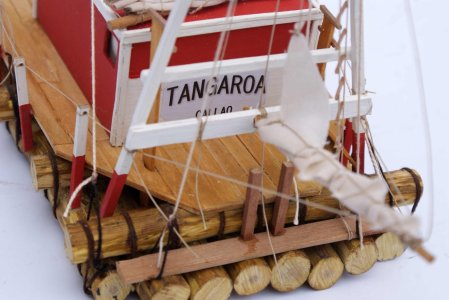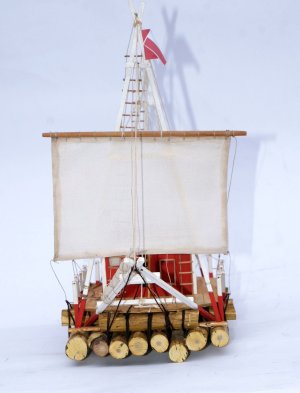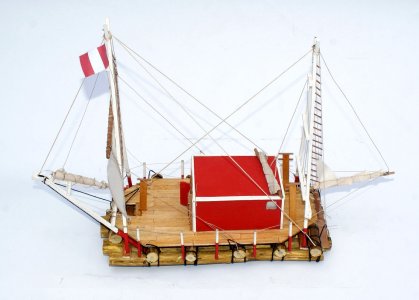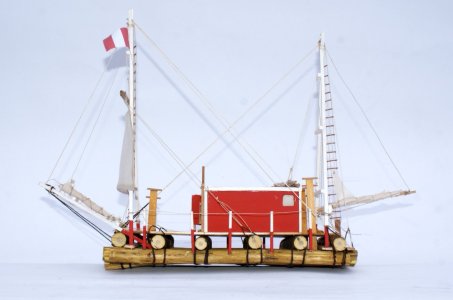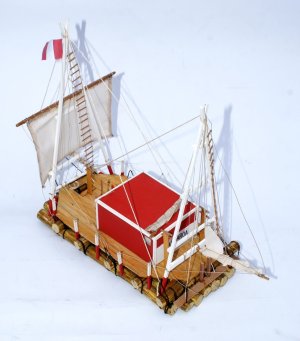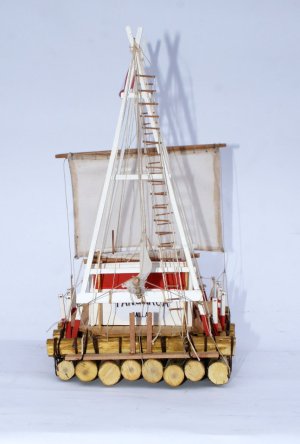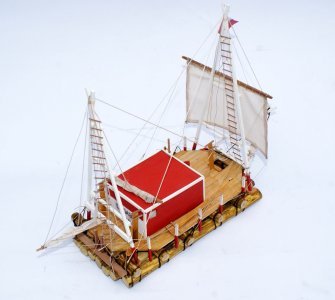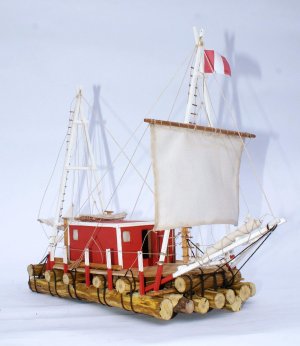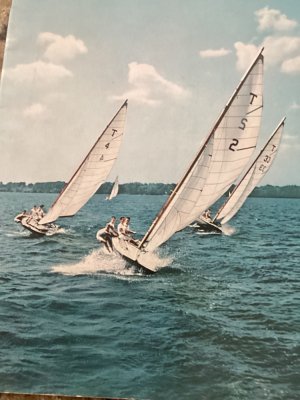I don't know if this raft qualifies as one of these beautiful ships that I see here, but it has an interesting history. Today I present a very simple model, but it is my recognition of the Peruvian expedition TANGAROA, headed by Don Carlos Caravedo Arca and two crew members who left Callao in 1965 and 115 days later arrived at the island of Fakarava in French Polynesia.
TANGAROA RAFT (Part 1 of 2)
1. HISTORY
It is our opinion that the theories about a maritime route between the territories of what is now Perú, and the islands of Oceania were not an idea that occurred to Mr. Heyerdahl in the mid-twentieth century, but that this possibility had been known since the sixteenth century. The Peruvian historian Federico Kaufmann in his article (Ref. 1) entitled “Tupac Yupanqui on his way to Oceania” writes in his first paragraph:
“According to the Castilian chroniclers Pedro Sarmiento de Gamboa (¿1530-1592?) and Miguel Cabello Valboa (¿1533-1608?), the Inca Túpac Yupanqui (Topa Inca or Túpac Inca Yupanqui) would have organized a maritime expedition departing from some point on the Pacific coast located in the territory of what is now Ecuador and which at that time was part of the Inca Empire. This journey was also commented on by Martín de Murúa (1560-1611), although in a succinct manner and without adding anything substantial.”
In 1947 Thor Heyerdahl made world news by making the first voyage with the Kon Tiki, followed by Willies' “Seven Little Sisters” (complete voyage); Ingris' La Kantuta (1955) (not complete, abandoned by the teredos); Tahiti Nui (1956) by Bisschop (not complete, abandoned due to teredos); Tahiti Nui II - III (1958) by Bisschop (ran aground on atoll and Bisschop died); La Kantuta II (1959) by Ingris (complete crossing); Tangaroa (1965) by Caravedo (complete crossing); La Pacífica (1966) by Alzar (lost due to teredos); La Balsa (1970) by Alzar (complete crossing, but partially tarred) and so on.
Below I transcribe some notes by Mr. Mario Knudsen, who (before the death of Carlos Caravedo in 2007) collected information on the actions and vicissitudes of the manager of this expedition.
“The Tangaroa raft was built by Carlos Caravedo Arca, who was head of the expedition. Balsa wood logs (tucos) from the Ecuadorian jungle were used by the undersigned, with the help of Mr. Guillermo Negrete, an Ecuadorian. I did not use male logs, but rather FEMALE ones, for proper flotation, although they would last less. The Peruvian crew consisted of: Carlos Caravedo Arca (Head of the expedition), Jaime Toledo Góngora and Jose Mataush Richtack. The Peruvian raft "TANGAROA" used a 6 x 4 meter sail plus a small mizzen sail.”
“He says, ..I encountered serious difficulties in building the raft; great difficulties in achieving the departure. I had to build the "TANGAROA" alone in a corner of the beach called "la mar brava" in Callao. While the "TANGAROA" was afloat and well conditioned - being the month of April - and ready, I was prevented from leaving. With my companions on the voyage, they imposed problems on us that the previous rafts that left Callao for Polynesia did not have. The refusal of the Harbor Master forced me to keep the "TANGAROA" anchored and flooded in the warf of the Peruvian Yacht Club in Callao, for three long months. In the month On July 26, 1965, in the middle of winter, I obtained permission. Thanks to the deafening noise produced by the sirens of the ships and other boats moored in the port, the "TANGAROA" left for Polynesia at 11 am on July 26, 1965. It was pulled from the Yacht Club to open sea. The Peruvian raft "TANGAROA" with its crew crossed the Pacific Ocean in 97 days to the archipelago and 115 days to the island of Fakarava, of which 18 days were spent passing the Tuamotu, being the only raft that has managed to cross the dangerous archipelago of French Polynesia on its own. On November 18, Fakarava island was the final point of our navigation. Fakarava is therefore the island of the "TANGAROA", where it is preserved.
It is important to mention that in 2006, a Norwegian crew with the participation of Heyerdahl's grandson prepared and carried out an expedition commemorating the 60th anniversary of the Kon Tiki, and they could not come up with a worse idea than to name the expedition “Tangaroa”. I understand that several people diplomatically approached them to change the name (although Tangaroa is not a registered name, since it means "god of the sea"); because 40 years earlier there was another Peruvian expedition with that name, but it seems that pedantry prevailed, and they ignored reasonable suggestions. Of course, films, copyrighted documentaries and all the paraphernalia that derives from the 2006 expedition were made, which is derived from an economic benefit or whatever. But I wanted to close this part of the story by comparing the interests of historical confirmations, adventure and research of the first expeditions, to the pecuniary motives of the latter.
As information on the handling of these rafts, their direction is carried out by means of the "guaras", which are not the planks placed vertically. A very good explanation is given in "Theory of navigation with guaras" www.runasimi.net
2. REFERENCES
Revista del Instituto de Estudios Histórico-Marítimo del Perú N° 19 Año 2000, pág. 109 “Tupac Yupanqui rumbo a la Oceanía”
http://expediciontangaroa1965.blogspot.com/2006/05/tangaroa-peruana-peruvian-vs-tangaroa.html
https://www.facebook.com/groups/expeditiontangaroa/
https://www.forosperu.net/temas/expedicion-tangaroa-y-carlos-caravedo.76907/
https://expeditiontangaroaraft1965.blogspot.com/
https://fernandolizamamurphy.com/2018/06/03/la-travesia-de-la-tangaroa/
http://boletinmaritimo.blogspot.com/2018/05/efemerides-maritimas-y-navales_53.html
http://expeditiontangaroaraft1965.blogspot.com/2008/06/expedicion-balsa-peruana-tangaroa.html
https://www.geocities.ws/tangaroa65/
http://www.runasimi.net/fateOfRafts-4UK.htm
3. MODEL CONSTRUCTION
There are no plans available for how the original Tangaroa raft was structured and built; therefore, the model made has been based on obtaining the dimensions from the available photographs, which I have taken to AutoCad and have correlated known measurements (barrel diameter, or diameter of the trunks, etc.) the true dimension will not be certain, but it is the best approximation I can obtain.
Decisions were also made about the number of poles that the raft had, in some comments it speaks of 8 spars and 5 transverses; but in the photos you can see 5 large transverses and one small one (at the bow) of 60 cm, regarding the spars there are contradictions since some documents speak of 8 and others of 9 of 80 cm, although in some notes it speaks of nine spars, in the final photos you can see that there are only eight spars.
For its construction I was not going to use round wood, so I went to my garden and “harvested” some branches as straight as possible, which I put to dry, then I just removed the bark and sanded a little. The longitudinal and transverse sticks were cut and glued, trying to make them as flat as possible; then the lashing between the trunks was simulated. Afterwards a planking, a shed and the rigging will be placed.
The flat arrangement of the logs was complicated, at end I used cyanoacrylate, the masts in “A” shape were prepared with 3x3 mm wood as well as the bowsprit; the boom and mizzen were 3mm and the main sail yard was 4mm diameter. It is worth mentioning that, having already prepared and shown the sails, the dimensions of the main square sail, which are 6 x 4 meters, seemed small to me, but that is how it was in the Caravedo documents, so I made and installed it.
Raft navigation has very particular characteristics, a detailed procedure is in reference 10. Better than a rudder, the raft's course can be set by means of the so-called “guaras”, which consist of wooden planks that are placed in a vertical position and can be moved towards the bow (port, starboard or central) and towards the stern (port and starboard); In the case of the Tangaroa raft, it had three rigging rods, which are shown raised in the model.
The masts, cabin and railings were painted red and white, as shown in some photographs at the time of departure. The stays were placed using a dark thread (similar to the tying of balsa masts), the rest of the halyards and ropes in raw thread. On one side of the cabin a rudder and a spare rigging rod are shown. No other elements are shown because at the time of departure, the deck was crammed with water cylinders, boxes, ropes,, etc.
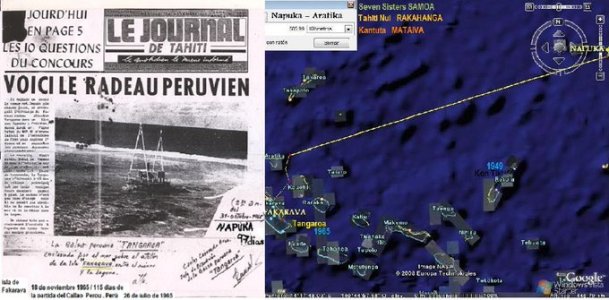
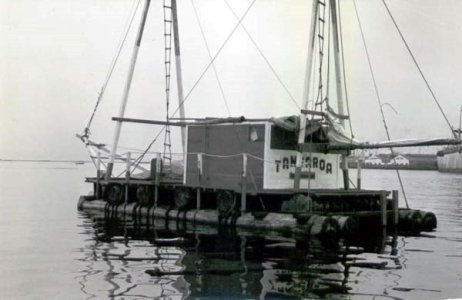
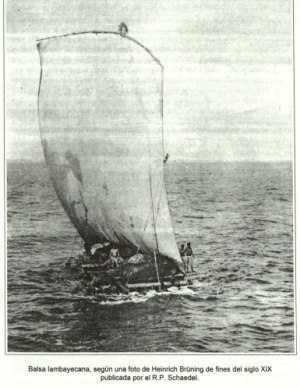
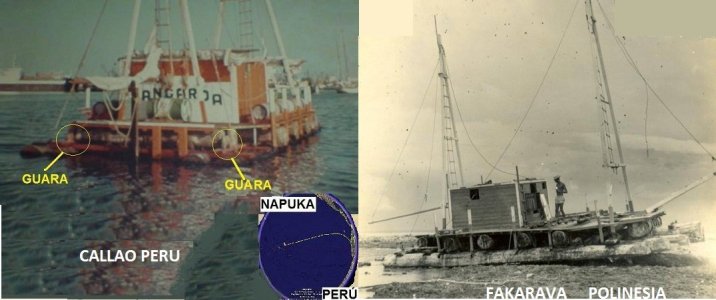
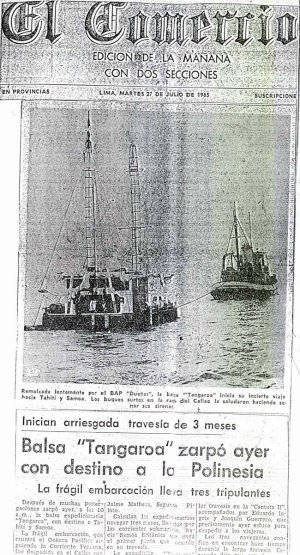
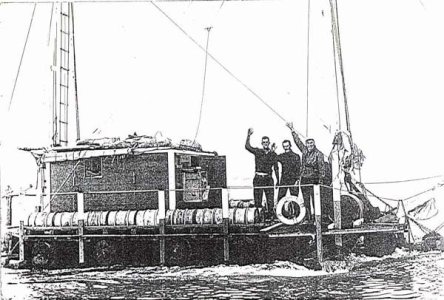
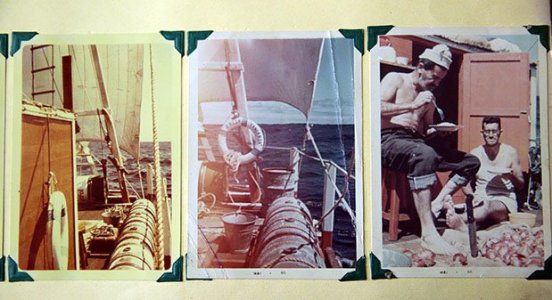
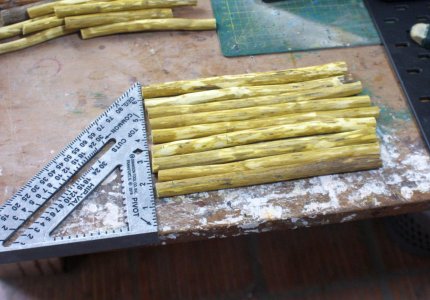
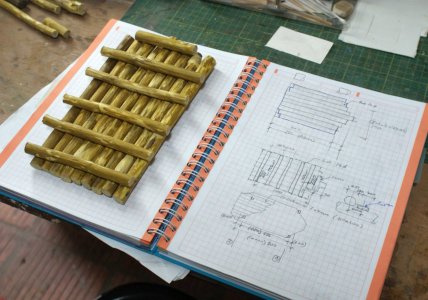
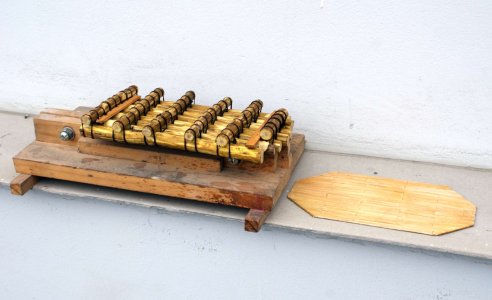
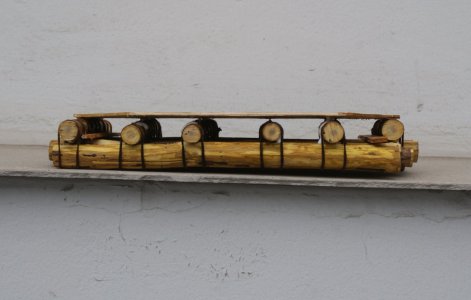
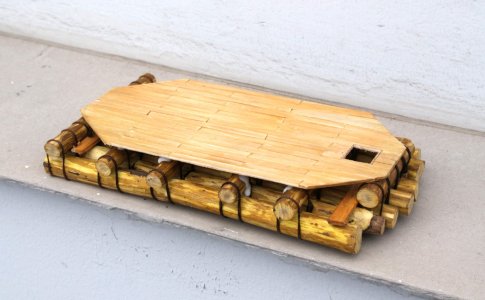
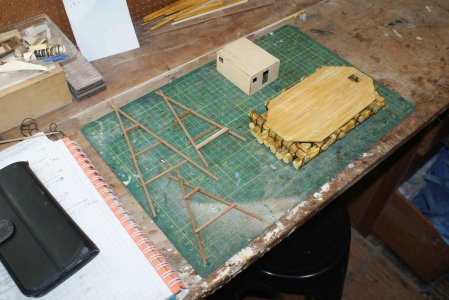
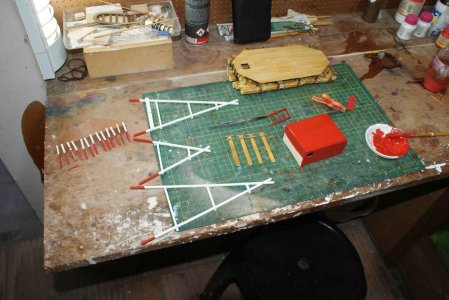
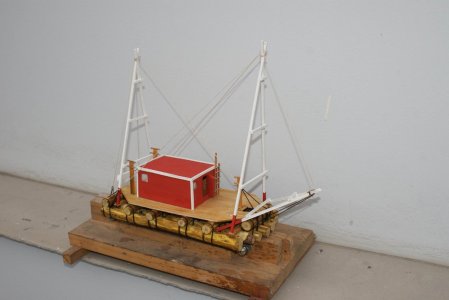
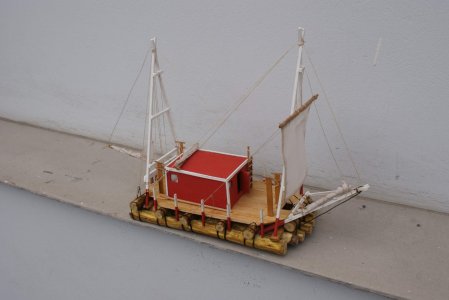
TANGAROA RAFT (Part 1 of 2)
1. HISTORY
It is our opinion that the theories about a maritime route between the territories of what is now Perú, and the islands of Oceania were not an idea that occurred to Mr. Heyerdahl in the mid-twentieth century, but that this possibility had been known since the sixteenth century. The Peruvian historian Federico Kaufmann in his article (Ref. 1) entitled “Tupac Yupanqui on his way to Oceania” writes in his first paragraph:
“According to the Castilian chroniclers Pedro Sarmiento de Gamboa (¿1530-1592?) and Miguel Cabello Valboa (¿1533-1608?), the Inca Túpac Yupanqui (Topa Inca or Túpac Inca Yupanqui) would have organized a maritime expedition departing from some point on the Pacific coast located in the territory of what is now Ecuador and which at that time was part of the Inca Empire. This journey was also commented on by Martín de Murúa (1560-1611), although in a succinct manner and without adding anything substantial.”
In 1947 Thor Heyerdahl made world news by making the first voyage with the Kon Tiki, followed by Willies' “Seven Little Sisters” (complete voyage); Ingris' La Kantuta (1955) (not complete, abandoned by the teredos); Tahiti Nui (1956) by Bisschop (not complete, abandoned due to teredos); Tahiti Nui II - III (1958) by Bisschop (ran aground on atoll and Bisschop died); La Kantuta II (1959) by Ingris (complete crossing); Tangaroa (1965) by Caravedo (complete crossing); La Pacífica (1966) by Alzar (lost due to teredos); La Balsa (1970) by Alzar (complete crossing, but partially tarred) and so on.
Below I transcribe some notes by Mr. Mario Knudsen, who (before the death of Carlos Caravedo in 2007) collected information on the actions and vicissitudes of the manager of this expedition.
“The Tangaroa raft was built by Carlos Caravedo Arca, who was head of the expedition. Balsa wood logs (tucos) from the Ecuadorian jungle were used by the undersigned, with the help of Mr. Guillermo Negrete, an Ecuadorian. I did not use male logs, but rather FEMALE ones, for proper flotation, although they would last less. The Peruvian crew consisted of: Carlos Caravedo Arca (Head of the expedition), Jaime Toledo Góngora and Jose Mataush Richtack. The Peruvian raft "TANGAROA" used a 6 x 4 meter sail plus a small mizzen sail.”
“He says, ..I encountered serious difficulties in building the raft; great difficulties in achieving the departure. I had to build the "TANGAROA" alone in a corner of the beach called "la mar brava" in Callao. While the "TANGAROA" was afloat and well conditioned - being the month of April - and ready, I was prevented from leaving. With my companions on the voyage, they imposed problems on us that the previous rafts that left Callao for Polynesia did not have. The refusal of the Harbor Master forced me to keep the "TANGAROA" anchored and flooded in the warf of the Peruvian Yacht Club in Callao, for three long months. In the month On July 26, 1965, in the middle of winter, I obtained permission. Thanks to the deafening noise produced by the sirens of the ships and other boats moored in the port, the "TANGAROA" left for Polynesia at 11 am on July 26, 1965. It was pulled from the Yacht Club to open sea. The Peruvian raft "TANGAROA" with its crew crossed the Pacific Ocean in 97 days to the archipelago and 115 days to the island of Fakarava, of which 18 days were spent passing the Tuamotu, being the only raft that has managed to cross the dangerous archipelago of French Polynesia on its own. On November 18, Fakarava island was the final point of our navigation. Fakarava is therefore the island of the "TANGAROA", where it is preserved.
It is important to mention that in 2006, a Norwegian crew with the participation of Heyerdahl's grandson prepared and carried out an expedition commemorating the 60th anniversary of the Kon Tiki, and they could not come up with a worse idea than to name the expedition “Tangaroa”. I understand that several people diplomatically approached them to change the name (although Tangaroa is not a registered name, since it means "god of the sea"); because 40 years earlier there was another Peruvian expedition with that name, but it seems that pedantry prevailed, and they ignored reasonable suggestions. Of course, films, copyrighted documentaries and all the paraphernalia that derives from the 2006 expedition were made, which is derived from an economic benefit or whatever. But I wanted to close this part of the story by comparing the interests of historical confirmations, adventure and research of the first expeditions, to the pecuniary motives of the latter.
As information on the handling of these rafts, their direction is carried out by means of the "guaras", which are not the planks placed vertically. A very good explanation is given in "Theory of navigation with guaras" www.runasimi.net
2. REFERENCES
Revista del Instituto de Estudios Histórico-Marítimo del Perú N° 19 Año 2000, pág. 109 “Tupac Yupanqui rumbo a la Oceanía”
http://expediciontangaroa1965.blogspot.com/2006/05/tangaroa-peruana-peruvian-vs-tangaroa.html
https://www.facebook.com/groups/expeditiontangaroa/
https://www.forosperu.net/temas/expedicion-tangaroa-y-carlos-caravedo.76907/
https://expeditiontangaroaraft1965.blogspot.com/
https://fernandolizamamurphy.com/2018/06/03/la-travesia-de-la-tangaroa/
http://boletinmaritimo.blogspot.com/2018/05/efemerides-maritimas-y-navales_53.html
http://expeditiontangaroaraft1965.blogspot.com/2008/06/expedicion-balsa-peruana-tangaroa.html
https://www.geocities.ws/tangaroa65/
http://www.runasimi.net/fateOfRafts-4UK.htm
3. MODEL CONSTRUCTION
There are no plans available for how the original Tangaroa raft was structured and built; therefore, the model made has been based on obtaining the dimensions from the available photographs, which I have taken to AutoCad and have correlated known measurements (barrel diameter, or diameter of the trunks, etc.) the true dimension will not be certain, but it is the best approximation I can obtain.
Decisions were also made about the number of poles that the raft had, in some comments it speaks of 8 spars and 5 transverses; but in the photos you can see 5 large transverses and one small one (at the bow) of 60 cm, regarding the spars there are contradictions since some documents speak of 8 and others of 9 of 80 cm, although in some notes it speaks of nine spars, in the final photos you can see that there are only eight spars.
For its construction I was not going to use round wood, so I went to my garden and “harvested” some branches as straight as possible, which I put to dry, then I just removed the bark and sanded a little. The longitudinal and transverse sticks were cut and glued, trying to make them as flat as possible; then the lashing between the trunks was simulated. Afterwards a planking, a shed and the rigging will be placed.
The flat arrangement of the logs was complicated, at end I used cyanoacrylate, the masts in “A” shape were prepared with 3x3 mm wood as well as the bowsprit; the boom and mizzen were 3mm and the main sail yard was 4mm diameter. It is worth mentioning that, having already prepared and shown the sails, the dimensions of the main square sail, which are 6 x 4 meters, seemed small to me, but that is how it was in the Caravedo documents, so I made and installed it.
Raft navigation has very particular characteristics, a detailed procedure is in reference 10. Better than a rudder, the raft's course can be set by means of the so-called “guaras”, which consist of wooden planks that are placed in a vertical position and can be moved towards the bow (port, starboard or central) and towards the stern (port and starboard); In the case of the Tangaroa raft, it had three rigging rods, which are shown raised in the model.
The masts, cabin and railings were painted red and white, as shown in some photographs at the time of departure. The stays were placed using a dark thread (similar to the tying of balsa masts), the rest of the halyards and ropes in raw thread. On one side of the cabin a rudder and a spare rigging rod are shown. No other elements are shown because at the time of departure, the deck was crammed with water cylinders, boxes, ropes,, etc.



















